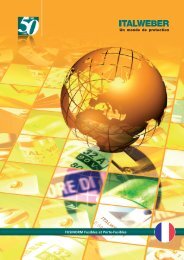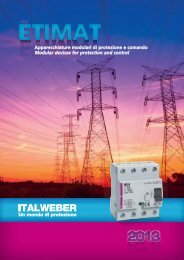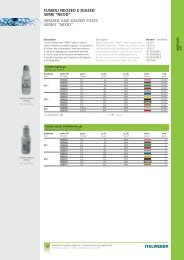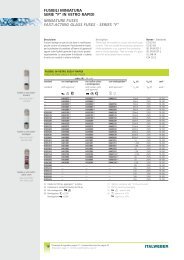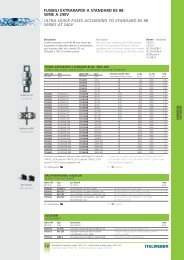Isoflex - Barre di rame e accessori - ITALWEBER
Isoflex - Barre di rame e accessori - ITALWEBER
Isoflex - Barre di rame e accessori - ITALWEBER
You also want an ePaper? Increase the reach of your titles
YUMPU automatically turns print PDFs into web optimized ePapers that Google loves.
INFORMAZIONI GENERALI<br />
E APPLICATIVE<br />
GENERAL INFORMATION<br />
AND APPLICATIONS<br />
<strong>Barre</strong> <strong>di</strong> <strong>rame</strong> flessibili<br />
Costituite da un pacco <strong>di</strong> lamine <strong>di</strong> <strong>rame</strong> inserite e protette da<br />
un isolamento in PVC autoestinguente (grado V0 secondo<br />
UL 1581). All’interno dell’isolamento le lamine sono libere <strong>di</strong><br />
scorrere offrendo illimitate possibilità <strong>di</strong> piegature e torsioni,<br />
e facilitando la preparazione delle parti terminali che sono<br />
realizzate sguainando il pacco lamellare e forando<br />
<strong>di</strong>rettamente lo stesso.<br />
Si tratta <strong>di</strong> un sistema <strong>di</strong> connessione rapido, moderno ed<br />
esteticamente efficace per il cablaggio <strong>di</strong> quadri elettrici.<br />
A parità <strong>di</strong> valore <strong>di</strong> intensità nominale <strong>di</strong> corrente, il<br />
risparmio <strong>di</strong> sezione è pari a circa il 40% rispetto all’impiego<br />
<strong>di</strong> un normale cavo.<br />
La tecnologia <strong>di</strong> costruzione garantisce uno spessore costante<br />
dell’isolante anche negli angoli; è inoltre previsto un gioco<br />
funzionale tra le lamine e l’isolante.<br />
Applicazioni:<br />
Cablaggi e collegamenti elettrici nei quadri <strong>di</strong> <strong>di</strong>stribuzione;<br />
Connessioni tra trasformatori e condotto sbarre;<br />
Connessioni tra condotto sbarre ed altre apparecchiature quali<br />
contattori, sezionatori ecc.;<br />
Giunti <strong>di</strong> collegamento;<br />
Possono essere usati in alternativa alle barre <strong>di</strong> <strong>rame</strong> rigide.<br />
Vantaggi:<br />
Risparmio <strong>di</strong> sezione (a parità <strong>di</strong> sovratemperatura,<br />
ammettono una densità <strong>di</strong> corrente più elevata rispetto alle<br />
barre rigide tra<strong>di</strong>zionali);<br />
Minori ingombri (sia perché l’alto grado <strong>di</strong> isolamento<br />
permette la riduzione delle <strong>di</strong>stanze tra fasi <strong>di</strong>verse e verso<br />
massa, sia perché l’assenza <strong>di</strong> vincoli <strong>di</strong> curvatura consente<br />
un notevole contenimento degli ingombri);<br />
Risparmio <strong>di</strong> tempo nella progettazione e realizzazione del<br />
quadro (anche grazie alla messa in forma manuale, senza<br />
l’ausilio <strong>di</strong> particolari attrezzature);<br />
Eliminazione <strong>di</strong> <strong>accessori</strong> (si collegano <strong>di</strong>rettamente alle<br />
apparecchiature senza capicorda o altri elementi <strong>di</strong> contatto);<br />
Aspetto del quadro estremamente moderno e professionale.<br />
Trecce <strong>di</strong> <strong>rame</strong> - standard e stagnate<br />
Realizzate in <strong>rame</strong> elettrolitico ricotto rosso o stagnate, impiegate<br />
per collegamenti <strong>di</strong> massa nell’industria elettromeccanica,<br />
ferroviaria e nel settore automotive. La completezza della gamma<br />
permette <strong>di</strong> sod<strong>di</strong>sfare qualsiasi esigenza nella quadristica e nei<br />
ponticellamenti <strong>di</strong> massa <strong>di</strong> qualunque tipo. La forma arrotondata<br />
della testata consente grande facilità <strong>di</strong> montaggio ed<br />
orientabilità anche in spazi ridotti. Garantiscono un contatto<br />
<strong>di</strong>retto e quin<strong>di</strong> un ottimo comportamento elettrico. L’estrema<br />
flessibilità le rende, ideali per le connessioni <strong>di</strong> potenza molto<br />
ravvicinate in quanto possono essere piegate senza problemi<br />
anche molto vicino al punto <strong>di</strong> connessione.<br />
<strong>Barre</strong> rigide in <strong>rame</strong> rosso e stagnate<br />
Sono realizzate in <strong>rame</strong> elettrolitico Cu-ETP <strong>di</strong> prima qualità, con<br />
bor<strong>di</strong> arrotondati. La versione in <strong>rame</strong> stagnato permette <strong>di</strong><br />
ridurre il tempo per la preparazione dei punti <strong>di</strong> contatto e<br />
assicura una efficace protezione duratura nel tempo contro gli<br />
agenti chimici aggressivi.<br />
244<br />
Flexible copper bars<br />
These are made up of copper sheets inserted in and protected<br />
by a self-extinguishing PVC insulation (V0 class accor<strong>di</strong>ng to<br />
standard UL 1581). Since the sheets can move freely inside the<br />
insulation, they offer a wide range of possible ben<strong>di</strong>ng and<br />
torsion configurations. In this way preparation of the terminal<br />
parts is simplified since they are obtained by removing the<br />
protection from the sheets and <strong>di</strong>rectly drilling the sheets pack.<br />
Therefore, this is a modern, aesthetically efficient and quick<br />
connection system for wiring electric panels. In fact, maintaining<br />
the same rated current load value, there is approximately<br />
a 40% saving in material respect to normal wire usage.<br />
The manufacture technique ensures a constant thickness<br />
of the insulation even in corners; in ad<strong>di</strong>tion, there is a<br />
functional clearance between the insulation and the sheets.<br />
Applications:<br />
Wirings and electrical connections in the <strong>di</strong>stribution panels;<br />
Connections between the transformers and the busbar<br />
system;<br />
Connections between busbar system and other equipment<br />
such as contactors, <strong>di</strong>sconnectors, etc.;<br />
Connection joints;<br />
Can be used as an alternative to solid copper bars.<br />
Advantages:<br />
Material saving (at the same overtemperature, they allow a<br />
higher current density than conventional solid bars);<br />
Less space requirements (both because the high insulation<br />
level permits reducing the <strong>di</strong>stance between the <strong>di</strong>fferent<br />
phases and towards earth and because the lack of ben<strong>di</strong>ng<br />
constraints allows a significant reduction of the space<br />
requirements);<br />
Time saving in the designing and buil<strong>di</strong>ng of the panel<br />
(also thanks to the manual mounting with no need for<br />
particular tools);<br />
No <strong>accessori</strong>es needed (they connect <strong>di</strong>rectly to the<br />
equipment without cable terminal or other contact elements);<br />
Extremely modern and professional design of the panel.<br />
Copper braids - standard and tin plated<br />
Made of electrolytic red copper or tin plated, used for<br />
earthing connections in the electromechanical, railway and<br />
automotive sectors. The range is so wide that it meets any<br />
requirement related to electric panel design and to any kind<br />
of earthing connections. The rounded shape of the head<br />
ensures easy mounting even with reduced space availability.<br />
They ensure a <strong>di</strong>rect contact and therefore an excellent<br />
electrical behaviour. Their excellent flexibility, in ad<strong>di</strong>tion,<br />
makes them the ideal solution for very close power<br />
connections, since they can be rea<strong>di</strong>ly bent even very close<br />
to the connection point.<br />
Plain copper bars - standard and tin plated<br />
They are made from the best quality electrolytic Cu-ETP copper,<br />
with rounded edges. The tin plated copper version permits<br />
saving time when buil<strong>di</strong>ng the contact points and guarantees<br />
an efficient long-lasting protection against aggressive<br />
chemical agents.<br />
<strong>ITALWEBER</strong>



